Abstract
Samples of 17-4PH high-strength steel were processed by selective laser melting (SLM) and solution-processed. The effects of the solution temperature on the microstructure and mechanical properties of the samples were studied. The 17-4PH high-strength steel is primarily composed of martensite, with a small number of austenite phases, and contains many dislocations. After the solution treatment, the grain size gradually increased, yielding typical martensite. The samples were subjected to an aging treatment after the solution treatment. Precipitates formed in the samples, conducive to improving their strength and hardness. The Vickers hardening and wear properties of the 17-4PH high-strength steel samples first increased and then decreased with increasing solution temperature. After the solution treatment at 1040 °C for 2 h and aging at 480 °C for 4 h, the Vickers hardening of the 17-4PH high-strength steel increased to 392 HV0.5, and the friction coefficient was approximately 0.6. These values were, respectively, 7% and 5% higher than those for the untreated samples.
1. Introduction
The 17-4PH high-strength steel is a low-carbon martensitic stainless steel containing nickel and copper that can be hardened by precipitation [1]. This stainless steel material has high strength and strong corrosion resistance [2,3]. It is widely used in medical devices, the chemical industry, automobile manufacturing, the military industry, the aerospace industry, and the nuclear industry. Owing to the melting point of this material, it can only be used for a long time at temperatures below 30 °C [4,5]. The intended application conditions of this steel evolve and become more stringent; consequently, the performance requirements become more demanding. The martensitic structure and the high hardness caused by precipitation hardening increase the processing difficulty of this material [6,7]. The traditional high-temperature processing technology cannot meet the requirements of the processing of parts, such as no casting process defects, and some complex parts [8]. This negatively affects subsequent deformation processing and heat treatment; as a result, complex welded parts can easily accumulate stress. Therefore, selective laser melting (SLM) forming technology was proposed in an attempt to address the forming problem [9]. SLM uses a metal powder that melts and cools rapidly under the heat of a laser beam, which overcomes the problems caused by traditional methods of manufacturing metal parts with complex shapes [10] The 17-4PH high-strength steel relies on the precipitation of the second phase to strengthen the material [11,12]. Martensitic transformation and aging treatment in order to form the precipitation hardening phase are the main strengthening methods [13] Along with SLM, solution treatment and aging treatment of 17-4PH high-strength steels also importantly affect SLM-based sample formation, with improved performance under application and service conditions [14].
Yadollahi et al. [15] studied the effects of heat treatment and crack orientation on the fatigue crack growth (FCG) behavior of 17-4PH stainless steel samples fabricated using a laser powder bed fusion (LPBF) additive manufacturing (AM) system. Their experimental results showed that following heat treatment, a large amount of delamination was observed in the crack propagation region of the specimens with transverse cracks. When the crack tip encountered a poorly bonded layer, a sudden deflection of the propagating crack also occurred in the specimens with longitudinal cracks, which were formed due to insufficient fusion or due to high residual stress. Qi et al. [14] studied the solution and aging treatments of 17-4PH stainless steel samples in a vacuum and under hot isostatic pressing (HIPA, HIPB, HIPC) conditions; the samples were prepared using SLM. The relative density, tensile strength, and ductility improved following the solution and aging treatments performed under the HIP conditions. Sun et al. [16] studied the effects of conventional solution and precipitation hardening (H-900) heat treatments on the microstructure evolution of 17-4PH AM and wrought components. These microstructural studies demonstrated that microstructures and hardnesses similar to those of wrought samples could be achieved in 17-4PH AM components by post-build heat treatments. Cheruvathur et al. [17] compared 17-4PH AM with forging 17-4 PH in conventional production. The effects of post-build thermal processing on the material microstructure were compared to those for conventionally produced wrought 17-4 PH with the intention of creating a more uniform, fully martensitic microstructure. Chung and Tzeng [18] studied the effect of aging treatment at 480 °C, 520 °C, and 620 °C on the microstructure and mechanical properties of metal injection molding (MIM) 17-4PH. A large number of fine spherical ε-Cu precipitates on the lath martensite matrix used to strengthen the MIM 17-4PH effectively prevented the movement of dislocations and yielded the highest hardness after aging at 480 °C.
However, there are only a few systematic studies on the effect of solution temperature on the microstructure and properties of 17-4PH. In this study, 17-4PH high-strength steel samples were prepared by SLM and then heat-treated to improve their mechanical properties. The effects of the solution temperature on the microstructure, hardness, friction, and wear and tensile properties of the SLM-formed 17-4PH samples were studied.
2. Experimental Procedures
The main chemical components (wt. %) of the 17-4PH high-strength steel powder are listed in Table 1. During the experiment, 17-4PH high-strength steel powder was screened, impurities in the powder were filtered out, and the filtered powder was put into a drying box for drying treatment. After drying, there was no moisture in the metal powder. In the experiment, EP-M150 selective laser melting forming equipment (Beijing Eplus 3D Tech. Co., Ltd, Beijing, China) was used. The instrument was equipped with a 200 W/500 W water-cooled fiber laser with a laser wavelength of 1060–1090 nm, and the protective atmosphere was argon. A chessboard-laser-scan strategy was adopted, and a laser focus diameter at the powder bed of 70 µm was used. Moreover, the SLM process parameters of the laser power (P), the scanning speed (v), the hatch spacing (h), and the layer thickness (t) were used in the experiment, and their values are listed in Table 2.

Table 1.
Chemical components (wt. %) of the 17-4PH high-strength steel powder.

Table 2.
SLM processing parameters used to produce the specimens.
Moreover, the starting temperature Ms of the transformation from the austenite structure to the martensite structure is above room temperature. After heat treatment, all the structures of the sample become martensite. However, when the solution temperature of the heat treatment is too high, the martensite structure is uneven, the Ms point decreases, the residual austenite increases, and the ferrite content also increases. All these make the heat treatment effect worse. Therefore, the heat treatment system (solution-treated at 940 °C, 990 °C, 1040 °C, 1090 °C, and 1140 °C for 2 h) was selected based on comprehensive consideration of these factors, and then the samples were quenched in water. After this process, the samples were aged at 480 °C for 4 h. The heat treatment system is presented in Table 3.

Table 3.
The heat treatment system for the SLM-formed 17-4PH high-strength steel.
The phase identification of the specimens’ surfaces (specimens’ dimensions: 10 mm × 10 mm × 10 mm) was performed using X-ray diffractometry (XRD) (D/max-Rb; Kα1, 0.15408 nm; acceleration voltage, 40 kV; current, 100 mA; diffraction angle range, 20–110°; scanning speed, 3°/min; Beijing Zhongke light analysis Chemical Technology Research Institute, Beijing, China). The specimens were polished and etched with a solution of 4 g CuSO4 + 20 mL HCl + 20 mL H2O. The microstructure and distribution of elements in the samples were examined through the use of a scanning electron microscope (SEM, JSM-7900F, JEOL Co., Ltd., Tokyo, Japan) equipped with an energy-dispersive spectroscope (EDS, JEOL Co., Ltd., Tokyo, Japan). The samples were processed to a thickness of 30 μm and were further thinned using a precision ion-polishing system. Transmission electron microscopy (TEM, JEM-2100F, JEOL Co., Ltd., Tokyo, Japan) observations were performed using a field emission gun operating at an accelerating voltage of 200 kV. The hardening behavior was measured using a Vickers hardness tester (HVS-1000, Shanghai Yanrun Light-Machine Technology Co., Ltd, Shanghai, China) under a load of 0.5 N and a holding time of 15 s. The specimen surfaces were kept flat and smooth and were assessed at 10 equidistant points. The mechanical properties of the samples were measured using an Instron 3382 mechanical properties testing system at room temperature (the strain rate was 1 mm/min, and an overall outline of the dimensions of the tensile specimen is shown in Figure 1). An HRS-2M high-speed reciprocating friction and wear tester (Lanzhou Zhongke Kaihua Technology Development Co., Ltd., Lanzhou, China) was used for non-lubricated friction and wear tests at room temperature. The load was 30 N, the friction speed was 300 t/s, the friction length was 5 mm, and the friction pair was a Si3N4 ceramic ball with a diameter of 0.4 mm.
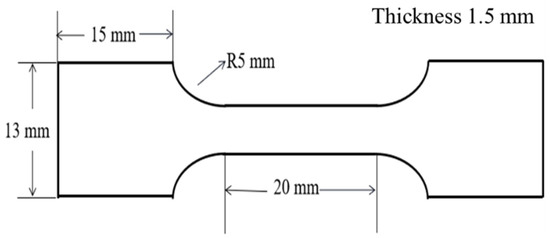
Figure 1.
An overall outline of the dimensions of the tensile specimen.
3. Results and Discussion
3.1. Effect of the Solution Temperature on the Microstructure
The TEM morphological images of the 17-4PH high-strength steel samples formed by SLM are shown in Figure 2. As the TEM sample becomes thinner, perforations tend to form in the fine grain at the boundary of the molten pool. Examining the TEM images, the samples’ structure mainly included lath martensite with the body-centered cubic (BCC) crystal structure and austenite grain with the face-centered cubic (FCC) crystal structure. As shown in Figure 2a, the width of the lath martensite was 200–300 nm. As shown in Figure 2b, the trace width of residual austenite along the boundary of the martensite lath was 200–300 nm. The crystal structure of the martensite was BCC, and a high density of dislocations was observed as shown in Figure 2c. Moreover, as shown in Figure 2d, many spherical inclusions (with particle sizes in the 50–170 nm range) were also present in the TEM images. According to the EDS composition analysis of the precipitates, the contents of the O and Si elements were high, and these spherical inclusions were determined to be Si-rich oxides.
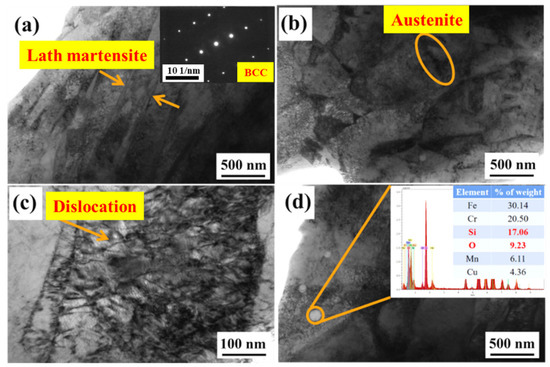
Figure 2.
TEM images of the morphology of the 17-4PH high-strength steel formed by SLM: (a) martensite; (b) austenite; (c) dislocation; (d) precipitates.
Barroux et al. [19] mention that the formation of these inclusions in the forming process is considered a manufacturing defect, despite the use of protective gas. Si-rich oxide inclusions were formed during the SLM-based production. Such inclusions, considered as manufacturing defects, were reported by several authors for 316 L stainless steel [20,21].
Figure 3 and Figure 4 show the SEM morphology and XRD patterns of the 17-4PH high-strength steel samples formed by SLM-based processing and subsequent heat treatment. Because the transformation point temperatures of 17-4PH high-strength steel are 670 °C for Ac1, 740 °C for Ac3, 140 °C for Ms, and 32 °C for Mf, the best performance requirements can be obtained by adjusting different heat treatment processes. Figure 3a shows a sample that was formed using SLM, and the structure is composed of lath martensite. Corresponding to the XRD pattern shown in Figure 3b, the structure also features the γ-austenite peak. After the heat treatment, the samples gradually formed a typical martensite microstructure as the temperature of the solution treatment increased. As shown in Figure 3c, the grain size increased as the solution temperature increased up to 940 °C, and all of the structures were transformed into α-martensite, as shown in Figure 3d.
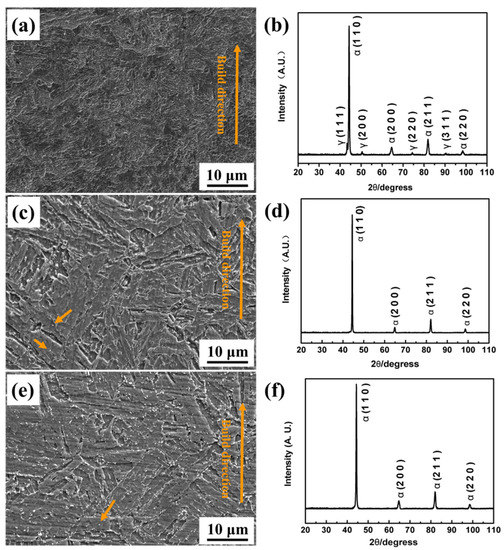
Figure 3.
SEM images of the morphology of 17-4PH high-strength steel: (a) SLM-processed; (c) heat-treated in solution at 940 °C; (e) heat-treated in solution at 990 °C. XRD patterns of 17-4PH high-strength steel: (b) SLM-processed; (d) heat-treated in solution at 940 °C; (f) heat-treated in solution at 990 °C.
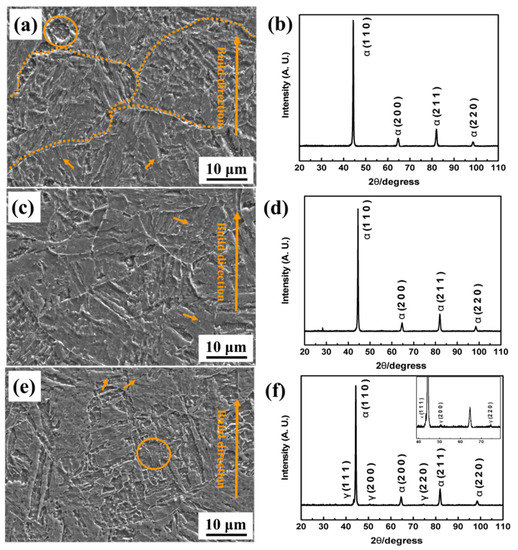
Figure 4.
SEM images of the morphology of 17-4PH high-strength steel: (a) heat-treated in solution at 1040 °C; (c) heat-treated in solution at 1090 °C; (e) heat-treated in solution at 1140 °C. XRD patterns of 17-4PH high-strength steel: (b) heat-treated in solution at 1040 °C; (d) heat-treated in solution at 1090 °C; (f) heat-treated in solution at 1140 °C.
The structures were completely austenitized during the heating of the solution and were transformed into lath martensite during the rapid cooling of the solution. When the solution temperature was 1040 °C, as shown in Figure 4a, the original austenite grains were arranged into package shapes (as indicated by the dotted line). Fine equiaxial grains were observed in the structure (the circle mark in the figure). A weak peak of γ-austenite was observed in the spectra of the specimens that were solution-treated at 1140 °C and the XRD patterns are shown in Figure 4f. The main peaks of α-martensite, as well as fine equiaxial grains, were observed (the circle mark in the figure). The starting temperature Ms of the austenite-to-martensite transformation was above room temperature. The solution temperature was too high; thus, Ms decreased and the retained austenite δ-ferrite also increased, but the hardness decreased. At this temperature, the heat treatment effect was not good. The orange arrows in Figure 3 and Figure 4 indicate the precipitated phase. During the aging process, the precipitation of precipitates such as ε-Cu was observed. A high density of dislocations was observed in the martensite, which is conducive to the diffusion of the copper phase. This is likely to improve the strength and hardness of the samples [18].
As shown in Figure 3 and Figure 4, in terms of the XRD patterns, the structure of the 17-4PH high-strength steel samples formed by SLM consisted of the intensive and main peaks of α-martensite and a weak peak of γ-austenite. A complete martensite structure was achieved after the heat treatment. When the solution temperature reached 1140 °C, the characteristic peak of γ (220) appeared again. Owing to the high temperature, Ms decreased, the temperature decreased, some austenite did not transform into martensite, and the amount of residual austenite increased.
3.2. Effect of the Solution Temperature on the Other Properties
3.2.1. Microhardness
Figure 5 shows the hardness values of the studied 17-4PH high-strength steel samples that were obtained using the SLM-based method and different solution treatment methods. The hardness improved owing to the heat treatment (the horizontal build direction was the X-Y section, and the vertical build direction was the X-Z section). When the solution temperature was increased to 1040 °C, the X-Y section hardness of the alloy samples peaked at approximately 392 HV0.5, while the X-Z section hardness peaked at approximately 381 HV0.5. Following that, the hardness of the alloy samples decreased as the solution temperature increased. The increase in the samples’ hardness was due to the strengthening effect caused by the complete martensite structure and small precipitates in the samples. The hardness values for the X-Y sections and the X-Z sections of the untreated samples that were made using the SLM-based method were the same. After the heat treatment, the hardness values of the X-Y and X-Z sections were different; the hardness of the X-Z section was lower than that of the X-Y section. For the solution temperature of 940 °C, the hardness was in the 360 HV0.5–365 HV0.5 range, similar to that of the non-heat-treated samples that were made using the SLM-based method. For the solution temperature of 1140 °C, the hardness of the X-Y section samples decreased to 383 HV0.5 and that of the X-Z section decreased to 375 HV0.5. This was because, at a solution temperature that was too high, the stability of the austenite increased and the transformation temperature Ms of the martensite decreased, resulting in an uneven martensite structure, a higher amount of retained austenite, higher ferrite content, and lower hardness. After the solution treatment, the microstructure became hard-phase martensite. The dispersed precipitation hardening phase that precipitates on the martensite lath during aging was shown to improve the matrix hardness [22]. Additionally, many dislocations were observed in the structure, which also affected the samples’ hardness.

Figure 5.
Microhardness of SLM-formed samples and heat-treated samples.
3.2.2. Wear Performance
Figure 6 shows the friction coefficient curves of the 17-4PH high-strength steel samples formed using the SLM-based method and heat-treated at solution temperatures in the 940–1140 °C range. Smooth friction coefficient curves were observed. According to the friction coefficient curves, for all samples, the friction coefficient tended to stabilize after the initial run-in period. The friction coefficient of the untreated samples was approximately 1, while the friction coefficients of the samples obtained for the solution temperatures of 940 °C, 990 °C, and 1140 °C fluctuated strongly around 0.8. The friction coefficient of the sample obtained for the solution temperature of 1040 °C increased rapidly during the first 6 min, and tended to stabilize after 6 min. The average friction coefficient decreased, the friction coefficient was approximately 0.6, and the antifriction performance improved. During friction, the microstructure of the sample’s surface was plastically deformed, which increased the actual contact area, resulting in a rapid increase in the friction coefficient. The solution temperature was 1140 °C. Owing to the high solution temperature, the Ms point decreased and the retained austenite δ-ferrite also increased. Austenite is a soft phase; thus, the hardness decreased and the friction coefficient increased.
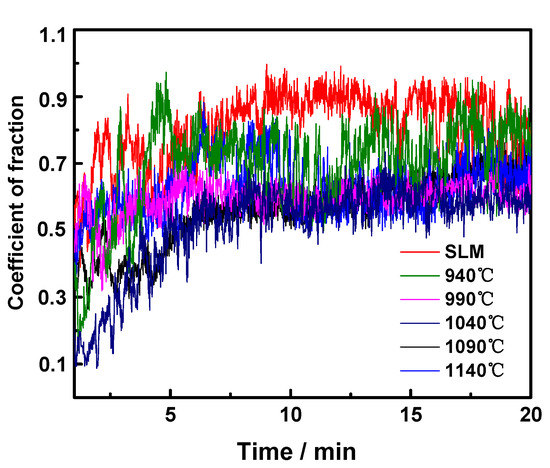
Figure 6.
The friction coefficient of SLM-formed samples and samples heat-treated at different solution temperatures.
Figure 7 shows the SEM morphologies of the wear surfaces of the 17-4PH high-strength steel samples obtained using the SLM-based method and heat-treated at different solution temperatures in the 940–1140 °C range. The types of wear that manifested were abrasive wear, adhesive wear, and fatigue wear. During friction, compressive and shear stresses were generated on the samples’ surfaces. As shown in Figure 7a, the samples’ surfaces became exfoliated, deformed, and scratched during the experiment, which led to the obvious roughening and tearing of the surfaces, as well as to the generation of plate-like wear debris. The material that was peeled off from the specimens’ surfaces owing to the propagation of microcracks was the main reason for the observed high wear rates. Figure 7b shows that the adhesive wear for the sample treated at 940 °C was the most obvious, resulting in a large amount of adhesive fine debris. Figure 7c shows that for the solution temperature of 990 °C, the hardness of the corresponding sample increased, and the adhesive wear and lamellar phenomena decreased. Figure 7d shows that for the solution temperature of 1040 °C, the surface of the corresponding sample was the smoothest. Owing to the high hardness and the low degree of wear, the main wear types were abrasive and slight adhesive wear. When the strength of the adhesive joint was lower than that of the two materials engaged in friction, shear occurred at the interface between the two materials. At this time, although the friction coefficient increased, the amount of wear was very small and the material transfer was minimal. Figure 7e shows that, for the solution temperature of 1090 °C, the fatigue wear was clear, and the surface of the sample could be peeled off in flakes, suggesting a high degree of damage. Figure 7f shows that, for the solution temperature of 1140 °C, delamination occurred, yielding a large number of loose wear particles. Some hard particles fell off and wore the surface materials of the contact surface owing to extrusions or relative motion. There were two specific mechanisms of plastic deformation and fracture during the wear process of abrasive particles. When the surface plasticity of the material was high, the abrasive particles scratched, with most of them producing grooves, and accumulation occurred on both sides. Subsequent repeated friction experiments will flatten the accumulated debris. In this way, an external force would eventually cause the formation of cracks and spalling.
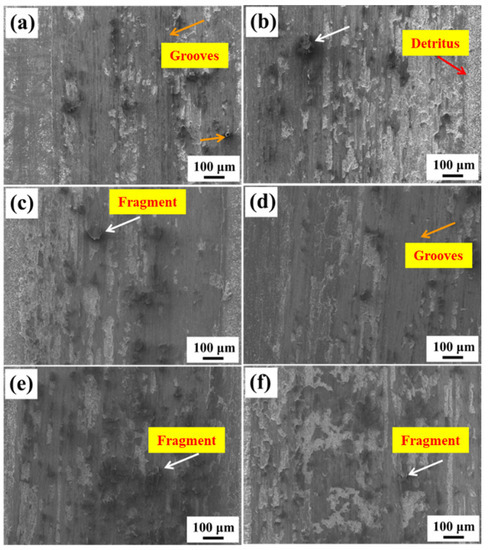
Figure 7.
SEM images of the morphology of the wear surface of 17-4PH high-strength steel formed by SLM. (a) SLM-formed sample; (b) sample heated-treated in solution at 940 °C; (c) sample heated-treated in solution at 990 °C; (d) sample heated-treated in solution at 1040 °C; (e) sample heated-treated in solution at 1090 °C; (f) sample heated-treated in solution at 1140 °C.
3.2.3. Tensile Properties
Figure 8 shows the stress–strain curves of 17-4PH high-strength steel formed by SLM and samples heat-treated at different solution temperatures in the 940–1140 °C range. On the whole, the tensile strength of the specimens after heat treatment is improved in different degrees compared with that before heat treatment. Particularly, when the solution temperature is 1040 °C, the trade-off between tensile strength and ductility is better displayed (the tensile strength is 1180 MPa, the strain is 0.16). Compared with Li et al. ’s the tensile properties after the homogenizing heat treatment [23], the tensile properties at the solution temperature of 1040 °C are mainly characterized by the fact that the tensile strength is improved to a certain extent compared with that before the heat treatment without sacrificing its toughness. Similarly, compared with Huber et al.’s modified heat treatments (involving prolonged solution annealing and deep-cooling) [24], the trade-off between tensile strength and ductility under the 1040 °C solution heat treatment in this study was also improved.

Figure 8.
Stress–strain curves of SLM-formed specimens and heat-treated specimens.
Figure 9 shows the SEM morphology results for the tensile fracture of the 17-4PH high-strength steel samples formed using the SLM-based method and processed at different solution temperatures in the 940–1140 °C range. After heat treatment, the tensile strength reached 1200 MPa. The elongation was in the range of 0.10 to 0.16. The tensile fracture surface consists of three distinct regions: the fiber, radiation, and shear lip regions. Figure 9a shows that many dimples and some micropores (orange arrows) formed on the surface of the untreated SLM-formed sample, and the sample exhibited a ductile fracture. As shown in Figure 9b, the sample that was treated at the solution temperature of 940 °C exhibited an obvious cleavage surface (marked by the orange circle) and shallow holes. Dimples were large and uneven, indicating a mixture of ductile and brittle fractures. With an increase in the solution temperature (as shown in Figure 9c for the solution temperature of 990 °C), the torn edge of the tensile part decreased and shortened, and the dimples became finer. As shown in Figure 9d, when the solution temperature increased to 1040 °C, the dimples on the fracture surface of the sample became similar in size and evenly distributed, which was also the reason for the high degree of elongation. The fracture surface of the sample exhibited an obvious necking phenomenon, which is a typical ductile fracture mechanism. As shown in Figure 9e, for the solution temperature of 1090 °C, the tensile strength of the sample increased, but the elongation decreased, resulting in a large number of cleavage surfaces and holes in the sample. As shown in Figure 9f, for the solution temperature of 1140 °C, the austenite in the sample structure reduced the strength of the material but improved the plasticity, tensile rate, cleavage surface, and micropore content of the material. After the heat treatment, the precipitated phase caused the formation of micropores during tension. The speed of the microporous polymerization process affects the toughness of the sample. The samples’ good strength and toughness are related to their structural uniformity and the presence of fine grains.
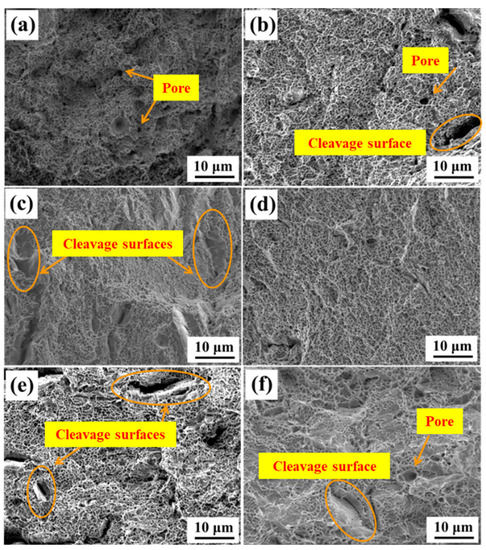
Figure 9.
SEM images of the morphology of the tensile fracture of 17-4PH high-strength steel formed by SLM. (a) SLM-formed sample; (b) sample heat-treated in solution at 940 °C; (c) sample heat-treated in solution at 990 °C; (d) sample heat-treated in solution at 1040 °C; (e) sample heat-treated in solution at 1090 °C; (f) sample heat-treated in solution at 1140 °C.
4. Conclusions
In this work, the effects of solution temperature (solution treatment at 940 °C, 990 °C, 1040 °C, 1090 °C, and 1140 °C for 2 h and aging at 480 °C for 4 h) on the microstructure and mechanical properties of 17-4PH high-strength steel samples that were obtained using the SLM-based process. Based on the experimental results, the following conclusions were reached.
First, the 17-4PH high-strength steel is primarily composed of martensite with a small amount of austenite phase and many structural dislocations. After the heat treatment, the martensite grain size increased gradually, and typical martensite microstructures emerged, eventually yielding a single-phase martensite structure. When the solution temperature was increased to 1140 °C, the Ms point decreased and the amount of retained γ-austenite and δ-ferrite also increased, but the hardness decreased. White precipitates were observed in the samples.
Second, the heat treatment improved the hardness, wear properties, tensile strength, and ductility of the 17-4PH high-strength steel samples formed using the SLM-based process. After the solution treatment at 1040 °C for 2 h and aging at 480 °C for 4 h, the Vickers hardness of the 17-4PH high-strength steel samples increased to 392 HV0.5, with a 7% improvement, and the friction coefficient was approximately 0.6, which was 5% higher than that of the untreated samples.
Author Contributions
Writing—original draft, Z.Z.; writing—original draft, investigation, data analysis and data collection, H.W.; writing—review and editing, P.H.; supervision, P.B.; conceptualization and methodology, W.D.; study design, X.L.; supervision, J.L.; conceptualization and methodology, W.Z. All authors have read and agreed to the published version of the manuscript.
Funding
This research was funded by the Major Science and Technology Projects of Shanxi Province, China (No. 20181101009), the Key Research and Development Project of Shanxi Province (201903D121009), and the Scientific and Technological Innovation Projects of Shanxi Province, China (2019L0608).
Institutional Review Board Statement
Not applicable.
Informed Consent Statement
Not applicable.
Data Availability Statement
Data are contained within the article.
Acknowledgments
The authors would like to thank the Major Science and Technology Projects of Shanxi Province, China (No. 20181101009), the Key Research and Development Project of Shanxi Province (201903D121009), and the Scientific and Technological Innovation Projects of Shanxi Province, China (2019L0608).
Conflicts of Interest
The authors declare no conflict of interest.
References
- Bressan, J.D.; Daros, D.P.; Sokolowski, A.; Mesquita, R.A.; Barbosa, C.A. Influence of hardness on the wear resistance of 17-4 PH stainless steel evaluated by the pin-on-disc testing. J. Mater. Process. Technol. 2008, 205, 353–359. [Google Scholar] [CrossRef]
- Dong, H.; Esfandiari, M.; Li, X.Y. On the microstructure and phase identification of plasma nitrided 17-4PH precipitation hardening stainless steel. Surf. Coat. Technol. 2008, 202, 2969–2975. [Google Scholar] [CrossRef]
- Alnajjar, M.; Christien, F.; Barnier, V.; Bosch, C.; Wolski, K.; Fortes, A.D.; Telling, M. Influence of microstructure and manganese sulfides on corrosion resistance of selective laser melted 17-4 PH stainless steel in acidic chloride medium. Corros. Sci. 2020, 168, 108585. [Google Scholar] [CrossRef]
- Murr, L.E.; Martine, E.; Hernandez, J.; Collins, S.; Amato, K.N.; Gaytan, S.M.; Shindo, P.W. Microstructures and Properties of 17-4 PH Stainless Steel Fabricated by Selective Laser Melting. J. Mater. Res. Technol. 2012, 1, 167–177. [Google Scholar] [CrossRef] [Green Version]
- Lin, X.; Cao, Y.Q.; Wu, X.Y.; Yang, H.O.; Cheng, J.; Huang, W.D. Microstructure and mechanical properties of laser forming repaired 17-4PH stainless steel. Mater. Sci. Eng. A 2012, 553, 80–88. [Google Scholar] [CrossRef]
- Hsiao, C.N.; Chiou, C.S.; Yang, J.R. Aging reactions in a 17-4 PH stainless steel. Mater. Chem. Phys. 2002, 74, 134–142. [Google Scholar]
- Yoo, W.D.; Lee, J.H.; Youm, K.T.; Rhyim, Y.M. Study on the Microstructure and Mechanical Properties of 17-4 PH Stainless Steel Depending on Heat Treatment and Aging Time. Solid State Phenom. 2006, 118, 15–20. [Google Scholar] [CrossRef]
- Yadollahi, A.; Shamsaei, N. Additive manufacturing of fatigue resistant materials: Challenges and opportunities. Int. J. Fatigue 2017, 98, 14–31. [Google Scholar] [CrossRef] [Green Version]
- Holland, S.; Wang, X.Q.; Fang, X.Y.; Guo, Y.B.; Yan, F.; Li, L. Grain boundary network evolution in Inconel 718 from selective laser melting to heat treatment. Mater. Sci. Eng. A 2018, 725, 406–418. [Google Scholar] [CrossRef]
- Ma, M.; Wang, Z.; Zeng, X. A comparison on metallurgical behaviors of 316L stainless steel by selective laser melting and laser cladding deposition. Mater. Sci. Eng. A 2017, 685, 265–273. [Google Scholar] [CrossRef]
- Sun, Y.; Hebert, R.J.; Aindow, M. Effect of Laser Scan Length on the Microstructure of Additively Manufactured 17-4PH Stainless Steel Thin-Walled Parts. Addit. Manuf. 2020, 35, 101302. [Google Scholar] [CrossRef]
- Bajguirani, H.H.; Servant, C.; Cizeron, G. TEM investigation of precipitation phenomena occurring in PH 15-5 alloy. Acta Metall. Mater. 1993, 41, 1613–1623. [Google Scholar] [CrossRef]
- Bhambroo, R.; Roychowdhury, S.; Kain, V.; Raja, V.S. Effect of reverted austenite on mechanical properties of precipitation hardenable 17-4 stainlesssteel. Mater. Sci. Eng. A 2013, 568, 127–133. [Google Scholar] [CrossRef]
- Si, Q.; Qin, F.; Li, K.F.; Liu, X.; Zhou, G. Effect of hot isostatic pressing on the microstructure and mechanical properties of 17-4PH stainless steel parts fabricated by selective laser melting. Mater. Sci. Eng. A 2021, 810, 141035. [Google Scholar]
- Yadollahi, A.; Mahmoudi, M.; Elwany, A.; Doude, H.; Newman, J.C. Effects of Crack Orientation and Heat Treatment on Fatigue-Crack-Growth Behavior of AM 17-4 PH Stainless Steel. Eng. Fract. Mech. 2020, 226, 106874. [Google Scholar] [CrossRef]
- Sun, Y.; Hebert, R.J.; Aindow, M. Effect of heat treatments on microstructural evolution of additively manufactured and wrought 17-4PH stainless steel. Mater. Des. 2018, 156, 429–440. [Google Scholar] [CrossRef]
- Cheruvathur, S.; Lass, E.A.; Campbell, C.E. Additive Manufacturing of 17-4 PH Stainless Steel: Post-processing Heat Treatment to Achieve Uniform Reproducible Microstructure. JOM 2016, 68, 930–942. [Google Scholar] [CrossRef]
- Chung, C.Y.; Tzeng, Y.C. Effects of aging treatment on the precipitation behavior of ε-Cu phase and mechanical properties of metal injection molding 17-4PH stainless steel. Mater. Lett. 2019, 237, 228–231. [Google Scholar] [CrossRef]
- Barroux, A.; Ducommun, N.; Nivet, E.; Laffont, L.; Blanc, C. Pitting corrosion of 17-4PH stainless steel manufactured by laser beam melting. Corros. Sci. 2020, 169, 108594. [Google Scholar] [CrossRef]
- Lou, X.Y.; Andresen, P.L.; Rebak, R.B. Oxide inclusions in laser additive manufactured stainless steel and their effects on impact toughness and stress corrosion cracking behavior. J. Nucl. Mater. 2018, 499, 182–190. [Google Scholar] [CrossRef]
- Kong, D.; Ni, X.; Dong, C.; Zhang, L.; Man, C.; Yao, J.; Xiao, K.; Li, X. Heat treatment effect on the microstructure and corrosion behavior of 316L stainless steel fabricated by selective laser melting for proton exchange membrane fuel cells. Electrochim. Acta 2018, 276, 293–303. [Google Scholar] [CrossRef]
- Yeli, G.; Auger, M.; Wilford, K.; Smith, G.; Bagot, P.; Moody, M. Sequential nucleation of phases in a 17-4PH steel: Microstructural characterisation and mechanical properties. Acta Mater. 2017, 125, 38–49. [Google Scholar] [CrossRef]
- Li, K.; Sridar, S.; Tan, S.; Wei, X. Effect of homogenization on precipitation behavior and strengthening of 17-4PH stainless steel fabricated using laser powder bed fusion. arXiv 2012, arXiv:2112.06289. [Google Scholar]
- Huber, D.; Stich, P.; Fischer, A. Heat Treatment of 17–4 PH Stainless Steel Produced by Binder Jet Additive Manufacturing (BJAM) from N2-Atomized Powder. Prog. Addit. Manuf. 2021. [Google Scholar] [CrossRef]
Publisher’s Note: MDPI stays neutral with regard to jurisdictional claims in published maps and institutional affiliations. |
© 2022 by the authors. Licensee MDPI, Basel, Switzerland. This article is an open access article distributed under the terms and conditions of the Creative Commons Attribution (CC BY) license (https://creativecommons.org/licenses/by/4.0/).